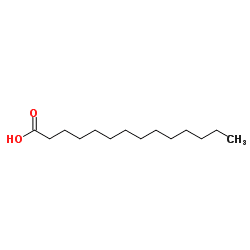Formula C14H28O2 Melting point 54.4 °C Density 862 kg/m³ | Molar mass 228.3709 g/mol Boiling point 250.5 °C | |
 | ||
Myristic acid meaning
Myristic acid, also called tetradecanoic acid, is a common saturated fatty acid with the molecular formula CH3(CH2)12COOH. A myristate is a salt or ester of myristic acid. Myristic acid is named after the nutmeg Myristica fragrans.
Contents
What does myristic acid mean
Occurrence
Nutmeg butter has 75% trimyristin, the triglyceride of myristic acid. Besides nutmeg, myristic acid is also found in palm kernel oil, coconut oil, butter fat and is a minor component of many other animal fats. It is also found in spermaceti, the crystallized fraction of oil from the sperm whale. It is also found in the rhizomes of the Iris, including Orris root.
Uses
Myristic acid is commonly added co-translationally to the penultimate, nitrogen-terminus, glycine in receptor-associated kinases to confer the membrane localisation of the enzyme. The myristic acid has a sufficiently high hydrophobicity to become incorporated into the fatty acyl core of the phospholipid bilayer of the plasma membrane of the eukaryotic cell. In this way, myristic acid acts as a lipid anchor in biomembranes.
The ester isopropyl myristate is used in cosmetic and topical medicinal preparations where good absorption through the skin is desired.
Reduction of myristic acid yields myristyl aldehyde and myristyl alcohol.
